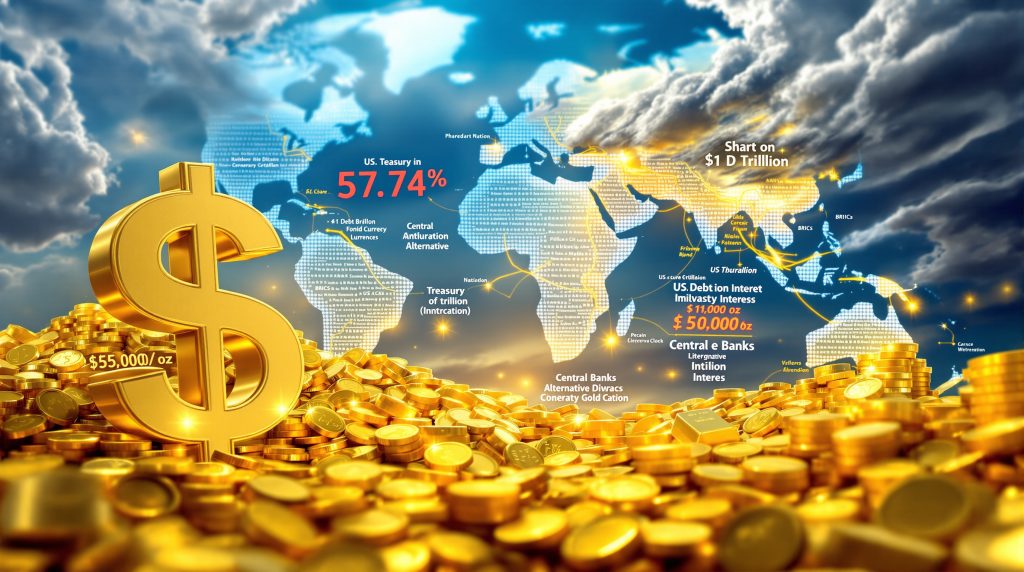Understanding the Global Reserve Currency Shift: What's Changing?
The global financial landscape is undergoing significant transformations as countries increasingly diversify their reserve holdings beyond the US dollar. This gradual yet meaningful shift reflects changing economic realities and strategic positioning by central banks worldwide. While the dollar maintains its dominance, the emerging trends point toward a more balanced multipolar currency system that could reshape international finance in the coming decades.
How Is the US Dollar's Global Reserve Status Evolving?
The US dollar's position as the world's primary reserve currency is experiencing a gradual but steady decline. According to the IMF's Currency Composition of Official Foreign Exchange Reserves (COFER) data, the dollar's share has fallen from approximately 71% in 2000 to 58.4% by the end of 2023. This represents a substantial shift in the global financial landscape, though the dollar still maintains a commanding lead over other currencies.
The Current State of Global Reserve Currencies
The distribution of global reserves currently stands at:
- US Dollar: 58.4% (Q4 2023)
- Euro: 20.06%
- Japanese Yen: 5.57%
- British Pound: 4.78%
- Chinese Renminbi: 2.7% (up from near zero in 2010)
- Other currencies: ~9%
This diversification trend has accelerated in recent years, with central banks actively seeking to reduce dependence on any single currency while maintaining stability in their reserves. The dollar's involvement in approximately 88% of all currency transactions further demonstrates its continued importance in global finance, despite the gradual decline in reserve holdings.
What's Driving the Shift Away from Dollar Dominance?
Several interconnected factors are contributing to the gradual erosion of dollar hegemony in the global financial system. These range from domestic US economic challenges to strategic international realignments that collectively signal a changing world order.
Growing US Debt Concerns
The United States' national debt has reached unprecedented levels, with the total federal debt surpassing $33.7 trillion as of December 2023. Annual interest payments on this debt reached $640 billion in fiscal year 2023, with projections suggesting these payments will exceed $1 trillion annually by 2030. This massive debt burden now consumes more resources than many essential government functions, raising questions about long-term fiscal sustainability.
For perspective, the current interest payments already consume nearly 80% of what the US spends on its entire defense budget ($816 billion in fiscal year 2023). This growing debt service requirement diverts resources from productive investments and creates potential vulnerabilities in the dollar's perceived stability.
Strategic Diversification by Central Banks
Central banks are methodically reducing their dollar exposure through several complementary strategies:
- Gradual portfolio rebalancing: Incrementally shifting portions of reserves to other currencies including the euro, yen, and increasingly, the Chinese renminbi
- Gold accumulation: Record-setting central bank gold purchases in recent years
- Regional currency agreements: Establishing bilateral trade arrangements that bypass the dollar entirely
These moves represent careful risk management rather than outright rejection of the dollar system. Central banks are hedging against potential instability while maintaining sufficient dollar reserves to meet immediate needs.
Geopolitical Tensions and De-dollarization Efforts
Geopolitical realignments have accelerated efforts to reduce dollar dependence:
- The BRICS nations (Brazil, Russia, India, China, South Africa) have expanded membership to include Iran, Egypt, Ethiopia, and the UAE in 2024
- Bilateral currency swap agreements have proliferated, allowing countries to trade directly in local currencies
- Nations subject to US sanctions have aggressively pursued dollar alternatives
Russia and China established a bilateral currency swap agreement worth ¥150 billion ($24 billion) in 2014, which has been expanded multiple times since. The European Union created INSTEX (Instrument in Support of Trade Exchanges) to facilitate trade with Iran while avoiding dollar-denominated transactions. These developments signal a deliberate move toward a more diversified international monetary system.
How Are Foreign Holdings of US Debt Changing?
The ownership structure of US government debt is shifting significantly, with important implications for market stability and interest rates. This transformation in debt ownership reflects broader changes in global economic relationships and priorities.
The Shifting Landscape of US Debt Ownership
Foreign holdings of US Treasury securities totaled approximately $7.6 trillion as of December 2023, representing about 30% of total marketable debt. While this remains substantial, it represents a decline from previous levels. Japan remains the largest foreign holder at $1.1 trillion, followed by China at $816 billion.
Who's Filling the Gap?
- Domestic institutions: US banks, pension funds, and mutual funds have increased their holdings
- Federal Reserve: Expanded its balance sheet through quantitative easing programs
- New players: Entities like stablecoin issuers have emerged as significant holders (Tether reported holding over $80 billion in US Treasury bills in their Q4 2023 attestation report)
The Implications of Changing Debt Ownership
This transition from foreign government holders to more profit-motivated private entities creates potential volatility risks:
- Private investors may sell quickly during market stress, unlike foreign central banks that typically hold for strategic reasons
- Domestic holders may be more sensitive to interest rate changes
- The Federal Reserve faces increased pressure to maintain market stability
The Congressional Budget Office notes that "increased reliance on domestic financing could lead to higher interest rates if foreign demand for U.S. securities declines significantly." This changing dynamic may require higher yields to attract sufficient buyers, potentially increasing borrowing costs throughout the US economy.
What Role Is Gold Playing in the Reserve Currency Shift?
Gold has emerged as a crucial element in the evolving reserve currency landscape, with central banks turning to the precious metal at rates not seen in generations. This renewed emphasis on gold signals a significant shift in monetary thinking and reserve management strategies.
Central Bank Gold Acquisition Trends
Central banks have been on a historic gold buying spree, with record purchases in recent years:
| Year | Central Bank Gold Purchases (tonnes) |
|---|---|
| 2022 | 1,136 |
| 2023 | 1,037 |
| 2024 | 975 (projected) |
This accumulation represents the most significant central bank gold buying since 1967, with emerging market central banks leading the charge. The People's Bank of China increased gold reserves by 225 tonnes in 2023 alone, while Turkey's central bank added 148 tonnes in the same period. Singapore's Monetary Authority nearly doubled its gold holdings from 125 tonnes to 221 tonnes between 2019-2023.
Motivations Behind the Gold Rush
According to the World Gold Council's 2024 Central Bank Gold Reserves Survey, 29% of central banks intend to increase gold reserves in the next 12 months. Their surveys reveal several key reasons for increasing gold reserves:
- Store of value: Protection against currency devaluation and inflation
- No counterparty risk: Gold isn't another country's liability
- Crisis hedge: Historically strong performance during financial instability
- Strategic diversification: Reducing dependence on any single currency
- Sanctions protection: Asset beyond the reach of foreign control
This systematic accumulation reflects a deliberate strategy to create more resilient reserve portfolios in an increasingly uncertain geopolitical environment.
Could a Gold Revaluation Impact the Global Reserve System?
Recent discussions about potential gold revaluation have moved from fringe speculation to more mainstream consideration, raising questions about gold's future role in addressing systemic challenges in the global financial system.
Historical Precedents for Gold Revaluation
Gold revaluations have occurred at pivotal moments in monetary history:
- Roosevelt's 1933 revaluation from $20.67 to $35 per ounce as part of the New Deal
- Nixon's 1971 suspension of gold convertibility, ending the Bretton Woods system
- Turkey's 2017 revaluation allowing banks to hold gold as part of their required reserves
These precedents demonstrate that major monetary shifts involving gold typically occur during periods of significant economic stress or system redesign.
The Federal Reserve's Research on Gold Revaluation
The Federal Reserve has examined historical gold revaluations by various countries, which has sparked discussion about potential US actions. Such a revaluation could theoretically:
- Create significant profit for the US government to address debt challenges
- Strengthen gold's role in the international monetary system
- Signal a shift in monetary policy approach
US official gold reserves are reported at 8,133.5 tonnes, valued at approximately $42.22 per ounce for accounting purposes according to Treasury reports. At current market prices (~$2,000/oz), these reserves would be worth approximately $522 billion. A significant revaluation could substantially increase this value.
Potential Revaluation Scenarios
While purely speculative, analysts have proposed various revaluation targets with different implications:
| Revaluation Level | Potential Impact |
|---|---|
| $10,000-20,000/oz | Partial debt relief |
| $20,000-50,000/oz | Significant debt reduction |
| $50,000+/oz | Potential complete debt elimination |
Financial experts remain divided on the likelihood of such actions, but the discussion by official institutions represents a notable shift in mainstream financial thinking. Rather than dismissing these possibilities outright, prudent investors recognize them as part of a range of potential future scenarios.
What Are the Implications of a Multipolar Currency System?
As the global financial system gradually evolves toward a more balanced distribution of currency power, both opportunities and challenges emerge for nations, institutions, and individual market participants.
Benefits of a More Balanced Reserve System
A more diversified global reserve currency landscape could offer several advantages:
- Reduced systemic risk: Less vulnerability to problems in any single economy
- More equitable global finance: Broader representation of economic powers
- Enhanced monetary policy autonomy: Less influence from dominant currency issuers
- Greater stability: Multiple stabilizing forces in the global system
The Peterson Institute for International Economics notes that "a gradual shift toward a multipolar currency system could reduce systemic risks but may initially increase volatility during the transition period." This balance of risks and rewards drives the careful approach most central banks are taking.
Challenges During Transition
The path to a multipolar currency system presents significant challenges:
- Market volatility: Uncertainty during transition periods
- Coordination difficulties: Lack of clear international frameworks
- Liquidity concerns: Fragmentation across multiple currencies
- Technological adaptation: Systems built around dollar dominance require updating
Central Bank Digital Currencies (CBDCs) development, including China's digital yuan pilot programs and the EU's digital euro project, may accelerate this transition by enabling new forms of cross-border settlement and reserve management. These technological innovations could reshape how reserves are held and deployed.
How Should Investors Respond to Reserve Currency Changes?
The evolving reserve currency landscape creates both risks and opportunities for investors across asset classes. A thoughtful, diversified approach recognizes the historic nature of these shifts while protecting against potential volatility.
Strategic Portfolio Adjustments
Forward-thinking investors are considering several approaches:
- Physical precious metals allocation: Increasing holdings of gold and silver as monetary metals with millennia of proven value
- Currency diversification: Reducing exposure to any single currency, particularly for those with substantial dollar holdings
- Real asset focus: Emphasizing tangible assets with intrinsic value
- Geographic diversification: Spreading investments across multiple economic regions
Norway's Government Pension Fund Global, the world's largest sovereign wealth fund, demonstrates this approach with approximately 70% in equities and 30% in bonds across multiple currencies, according to their 2023 annual report. This balanced approach helps mitigate specific currency risks while maintaining growth potential.
The Importance of Preparation Over Timing
Rather than attempting to predict exact timing of major shifts, prudent investors focus on:
- Building positions gradually in protective assets
- Maintaining adequate liquidity for opportunities
- Reducing dependence on any single currency or asset class
- Understanding historical patterns of monetary transitions
This preparation-focused approach recognizes that major monetary transitions typically unfold over years or decades, with periodic acceleration during crisis periods. It prioritizes resilience over precise market timing.
What Timeline Can We Expect for These Changes?
Historical precedent suggests reserve currency transitions occur gradually, with occasional periods of acceleration during crises. Understanding these patterns helps create realistic expectations about the pace of change.
The Evolutionary Nature of Reserve Currency Shifts
Reserve currency transitions have historically unfolded over extended timeframes:
- The British pound's transition from primary reserve currency took approximately 30-40 years (1920s-1960s), with the process accelerated by two world wars and the Bretton Woods Agreement
- The Euro's adoption process from the Maastricht Treaty (1992) to full implementation (2002) took a decade
- The US dollar's rise to dominance was evolutionary rather than revolutionary
Central banks typically move cautiously to avoid disrupting their own reserves and the broader financial system. This institutional conservatism tends to extend transition periods, even when the direction of change becomes clear.
Potential Acceleration Factors
Several developments could accelerate the timeline:
- A severe US fiscal crisis
- Major geopolitical realignments
- Technological disruptions in payment systems
- Coordinated policy shifts by major economic blocs
Blockchain-based payment systems and central bank digital currencies (CBDCs) could potentially accelerate transitions by enabling new forms of international settlement that bypass traditional currency channels.
Frequently Asked Questions About Global Reserve Currency Shifts
Will the US Dollar Collapse?
A sudden, catastrophic dollar collapse appears unlikely given:
- The dollar's deep integration into global trade and finance
- The absence of a ready alternative with sufficient depth and liquidity
- The interconnected nature of the global financial system
- The mutual interest in stability among major economic powers
Instead, a gradual erosion of dominance appears more probable, potentially spanning decades rather than years. The dollar will likely remain significant even in a more balanced multi-currency system.
Could Digital Currencies Replace Traditional Reserve Assets?
Central Bank Digital Currencies (CBDCs) and other digital assets may play an increasing role in the reserve system, but face significant hurdles:
- Governance and security concerns
- Technological limitations
- Regulatory uncertainties
- Limited track records compared to established currencies
While digital innovations will influence the evolution of reserve currencies, they're likely to complement rather than completely replace traditional assets in the near term. The integration of digital and traditional reserve assets may create a hybrid system during the transition period.
How Would a Reserve Currency Shift Impact Average Citizens?
The effects would likely include:
- Purchasing power changes: Potential inflation or deflation depending on currency movements
- Interest rate adjustments: Changes in borrowing costs for mortgages, loans, and credit
- Investment performance shifts: Different asset classes performing differently
- Trade relationship changes: Altered pricing for imports and exports
These impacts would unfold gradually for most citizens, with the most noticeable effects likely coming during periods of accelerated transition triggered by economic stress or policy changes.
Preparing for a Changing Monetary Landscape
The global reserve currency shift is undergoing a gradual but meaningful transformation. While the US dollar maintains its dominant position for now, diversification trends are clear and accelerating. Central banks are strategically repositioning their reserves, with gold prices as inflation hedge playing an increasingly important role as a neutral reserve asset.
Rather than a sudden revolution, we're witnessing an evolution toward a more multipolar currency system. This transition will likely continue for years, potentially decades, creating both challenges and opportunities for nations, institutions, and individual investors.
Those who understand these shifts and position accordingly may find themselves better prepared for the monetary landscape of tomorrow – one that may look quite different from the dollar-dominated system that has prevailed since the mid-20th century.
Understanding the historical patterns of previous reserve currency transitions provides valuable context for navigating the current changes. By observing central bank actions rather than just their words, investors can gain insight into how the world's monetary authorities are preparing for this evolving landscape. The gold price forecast suggests continued strength as this transition unfolds.
In planning for the future, investors should consider a diverse range of 2025 investment opportunities that can withstand currency volatility and potentially benefit from structural changes in the global financial system. Developing a comprehensive investment strategy 2025 that includes exposure to alternative currencies, precious metals, and products like an ETC investment guide can help navigate this changing landscape. Furthermore, staying informed about de-dollarization trends and understanding the role of reserve currencies will be essential for financial planning in the coming years.
Want to Stay Ahead in the Mining Investment Game?
Discover high-potential ASX mineral discoveries the moment they happen with Discovery Alert's proprietary Discovery IQ model, delivering real-time alerts that turn complex data into actionable investment opportunities. Explore why historic discoveries generate substantial returns by visiting the dedicated discoveries page and begin your 30-day free trial today.




